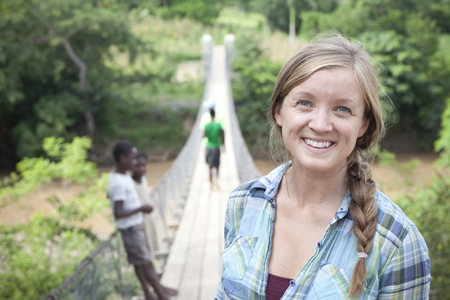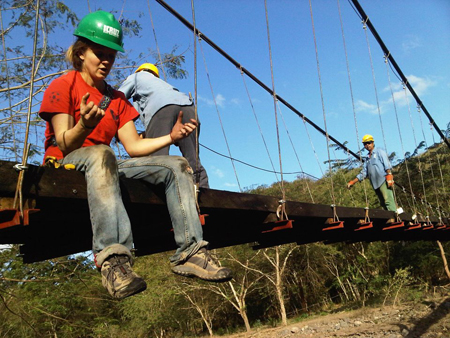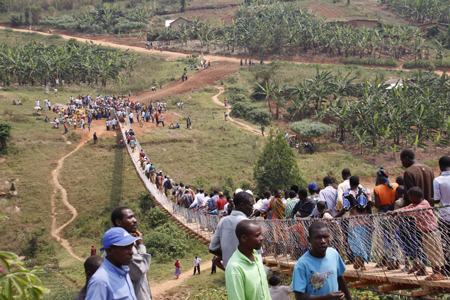
Bridge design & engineering caught up with her in London last month after her keynote lecture at Footbridge 2014, to find out more about her work, what makes her tick and what inspires her.
What's your background?
I grew up in Iowa, the daughter of an engineer and an incredibly powerful and inspiring mother. As a kid I was an athlete, and was fortunate to be able to play soccer for the University of Iowa while working on degrees in art and civil engineering. After a semester abroad in Fiji, I returned to the states with a real sense of both my own privilege, and my purpose. I realised that something as simple as a bridge could create immense change in a community, and that I had the power to work with rural communities to build bridges that would provide safe and reliable access to the kinds of services and opportunities that every person needs to not only meet their basic needs – but to grow and to thrive.
How did you first get involved in bridges?
I was always compelled to follow in dad's footsteps as a civil engineer, because there's something so inspiring about creating safe, beautiful infrastructure that has such a profound impact on our daily lives. Very few people can say they spent childhood vacations visiting public works projects, but I can safely say my love for infrastructure, and bridges in particular, was ingrained from an early age. My experience in Fiji further compelled me to seek out work with bridges, because of the ability of a bridge project to leverage locally available services, skills, and resources within a community to improve the standard of living for all people within that community.
How did you first become aware of B2P and its work?
I was living in Fiji during a semester abroad and had the opportunity to visit the remote island of Taveuni, where the New Zealand government had recently built a bridge. The pedestrian bridge was life-changing for community members living on the near side of the river, who were previously isolated from school nearly half of the year. Since the construction of the bridge, farmers had access to the weekly market, kids were able to go to school, and the entire community now had access to the healthcare facility in town. I suppose you could say I had a eureka moment, realising that something so simple as a footbridge could have such a profound impact for thousands of people. I searched for non-profit organisations that focus on the global challenge of isolation, and found Bridges to Prosperity. I called B2P’s founder Ken Frantz, and only half convinced of the idea myself, talked him into letting me and a group of colleagues from the University of Iowa build a bridge with B2P in Peru. After 18 months and plenty of red tape, we completed B2P’s first university programme bridge in partnership with the community of Yavina Peru, and I was hooked.

How did you become CEO?
I first joined the B2P board of directors while working at a structural engineering firm, and after a brief hiatus, joined up again when I returned to graduate school at the University of Colorado at Boulder. During those first years as a volunteer, I founded the Bridges to Prosperity University programme because I saw the opportunity for engineering students to be engaged in this exciting work in a very hands-on way. The university programme has since grown to include university teams from all over the world, and those teams play an important role in B2P’s ability to establish sustainable bridge building operations in our partner countries, as B2P aims to build local capacity (in lieu of building dependence on foreign aid) by training local construction managers, masons, and partners such as universities and established non-governmental organisations. The B2P university programme empowers university teams to become self-sufficient entities that can help to build that local capacity in the communities where we work. In 2008, after volunteering on projects in Peru and Honduras and serving on the B2P board, I challenged B2P’s founder Ken Frantz to bring me on as Bridges to Prosperity's first US-based paid staff member, provided I could fundraise for my own salary. I pride myself in engaging incredibly bright and dynamic people as partners, volunteers, and staff, and six years later, I am thrilled by what we've been able to accomplish in partnership with the rural communities we work with all over the world. Together, we've developed a scalable model to ensure safe year-round access to schools, markets and health clinics through pedestrian bridge building and training in rural developing communities, and that has very exciting implications for the future.
Is there such a thing as a typical day for you?
I travel a ton, so my day-to-day work life changes pretty drastically on a regular basis. I relish that within a week's time, I can go from a speaking engagement in London to a bridge build in Nicaragua. That kind of variation helps me stay close to our organisation's mission and operations, and still keep up on the exciting things happening in the transportation and international development arenas throughout the world. What are your key responsibilities? From my perspective, one of the most important components of leadership is serving as a driving force for your organisation's mission. It's my job to lead my team and our partners in executing a vision that frankly, is very ambitious: we envision a world where poverty caused by rural isolation no longer exists. My role is to build and support an incredible team of people capable of tackling a goal that big, and provide the resources and leadership that empower each person to do what they do best.

What are the biggest challenges facing B2P in delivering its vision at strategic level?
Monitoring and maintenance continue to be our biggest challenges, but we're making great strides in those areas. We've recently been working with Portland State University's Sweetlab to install small-but-mighty remote monitoring devices that allow us to track foot traffic on a bridge, and by 2015, we aim to have a sensor on each new bridge we build to further ensure we are building our bridges in the right places. With each new bridge project, we work with our partner community to build local capacity to maintain bridges for the long-term, and we return to our projects at regularly scheduled intervals to perform inspections and work with communities to provide any key maintenance or improvement tasks. As we scale up operations, we're working to ensure our inspection and maintenance practices are sustainable by growing our network of expert volunteers. Through the bridge corps, members serve both in the field and remotely, travelling the world to provide training and build projects, or working on technical initiatives, checking designs, or mentoring university teams. This will allow us to significantly expand our capacity, efficiency, and sustainability as an organisation, as well as engage enthusiastic and brilliant people from all over the world in our key operations.
What are the biggest challenges you face at local level?
The challenges and opportunities presented by any particular project vary pretty widely, though there are some challenges that are just inherent in our field of work. We work to source materials locally whenever possible, and that is an especially tough task in rural, developing communities. Working directly with local leaders, and requiring the communities that will be served by the bridge to be invested in planning and construction is wonderfully helpful in navigating potentially challenging social and political situations, and we are learning more about how to improve that process with each new bridge we build. I am constantly amazed and inspired by how people from vastly different backgrounds can come together to make a bridge happen. It's beautiful, and it's energising.
How do you prioritise the countries and places you work in?
Selecting new countries is a difficult task, as there are thousands of communities around the world experiencing extreme isolation. We select countries and regions within countries based on high need, which is defined by a number of factors, including the World Bank’s Rural Access Index, and aligned resources. Within a given region, we work with ministries of infrastructure and aligned municipalities and districts to prioritise areas and communities with highest need. Those with greatest need and support from their district are visited and selected based on their prioritisation of the project, willingness to support, own and operate the project and B2P’s ability to train local construction managers and masons on the bridge. Community engagement and training is key to the long-term sustainability of each bridge we build, which is why we take particular care to work with communities that are invested and committed at every step in the process – from planning, to construction and inauguration, and ultimately, monitoring and maintenance.

What's the biggest challenge you face in your day to day job?
Time! I think my staff would echo that sentiment. At any given point, we have 200 potential projects on the docket and countless other communities in need of a bridge that we haven’t reached yet. We need more hours in the day!
How many staff/volunteers do you have right now, and how has that changed in recent years?
Right now, we have 13 full time staff members, in addition to about a dozen interns and dozens more bridge corps members that are engaged in our work in a very significant way, at any given time. On an annual basis, we have several hundred students and professional volunteers involved in both on-the-ground bridge builds and remote technical assistance. Our growth has been organic, but steady.
What countries are you currently working in, and which companies do you have partnerships with?
We have active training programs in Haiti, Nicaragua, Panama, Bolivia, and Rwanda, and have completed programs in Honduras, El Salvador, Peru, Zambia, Kenya and Ethiopia. We have partner and follow-up programmes in Timor-Leste and Guatemala while supporting projects in half dozen other countries from Mozambique to Albania. We have been invited to work with partners in a number of countries, primarily throughout Asia and Africa, but our current focus remains on building out greater capacity within our existing partner countries, with a five-year goal to expand to new strategic geographic areas of work.
Do you have a favourite bridge that you have built?
Our very first bridge project crosses the Blue Nile in Ethiopia, and probably because it was the first, and because we learned so much from the experience, it will always hold a special place in my heart. Our original steel truss solution was torn down during a high water event and we returned to the community to rebuild: this time a 90m cable supported suspended bridge that extended farther up the mountainside. With over 10,000 villagers in the region benefitting from the bridge, the enthusiasm and support for the project was tremendous force that I feel fortunate to have been part of.
What about a favourite bridge designed or built by someone else?
I have a particular soft spot for the Brooklyn Bridge- not just because of its obvious function as a main vein to Manhattan, but perhaps more so for its historical context. I remember reading about how Emily Warren Roebling was an unsung hero, serving as a key messenger between her ailing husband and the bridge’s work crews when he became too ill to be on site to oversee construction. There is something really inspiring about a young woman leading such an incredible project given the roles and opportunities typically available to women in the 1870s.
Are there particular bridge designers or builders who inspire you?
I had the opportunity to meet the Schlaich Bergermann & Partner team while at the Footbridge 2014 conference in London and was floored by their simple designs, where form clearly followed function. Although new to my repertoire, I aspire to be like those guys someday. That said, I am consistently impressed by the engineers, staff, students and professional volunteers alike, that design our bridges to be both functional and stunning, and capable of being built by hand from locally sourced materials. That's not an easy feat.
What's the most memorable experience you've had in this job?
Because there is often cynicism around international development projects, I am constantly amazed by the tenacity, passion, and brilliance of the people I encounter in my work: our staff, our partners, our volunteers, and above all, the communities we work with. Time and again, despite the laundry list of challenges we encounter with each project, we pull it off. We come together to build beautiful, safe, and lasting bridges that create crucial access and opportunities for rural communities all over the world.
What makes you excited to go to work every day?
In my work, I have seen over and over that compassion begets compassion, and that all people are capable of becoming change-makers. That is a powerful and encouraging thought, and it moves me forward.

What is your future vision for B2P?
I am challenged daily to think of how to use the platform I have to create positive change that can scale, not only to reach dozens of new communities a year, but hundreds and thousands. Each new step we take as an organisation is taken with this goal in mind. With the right partners, I think we can get there.



